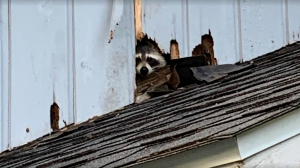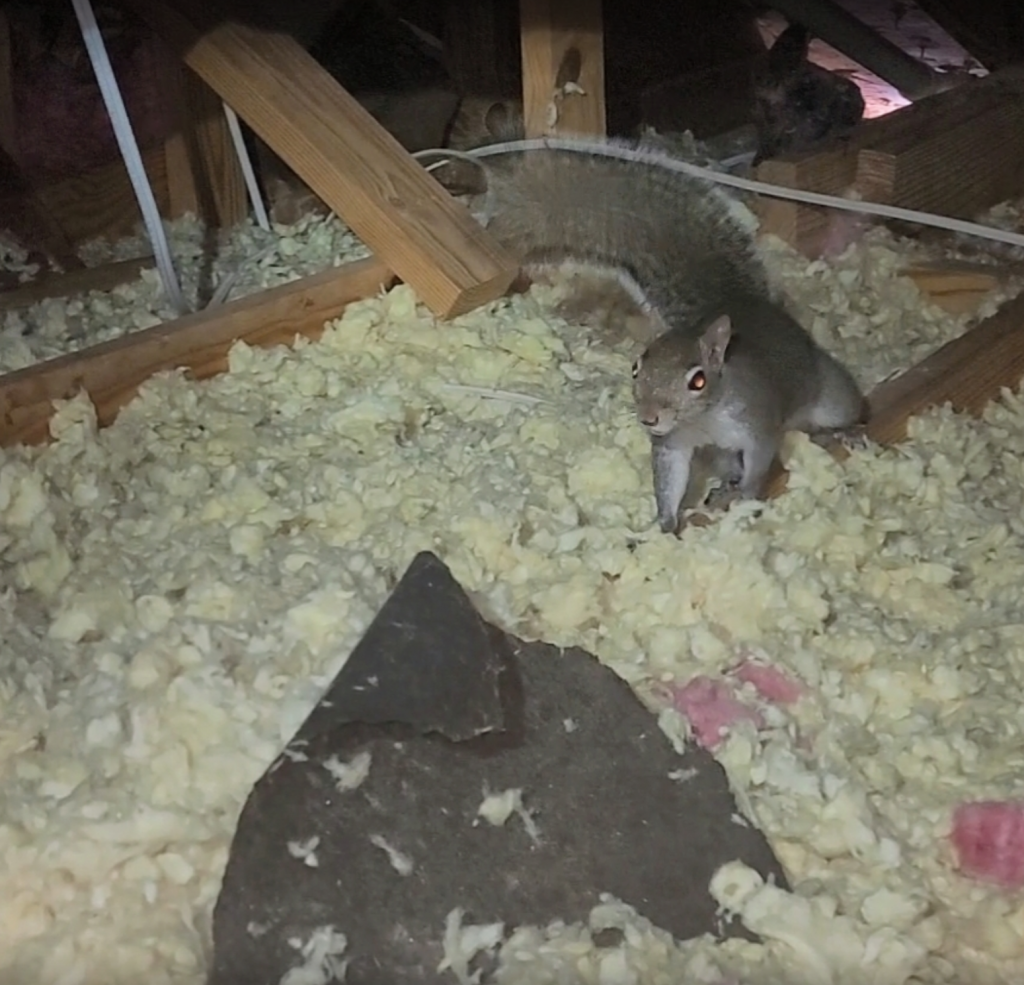You depend on your roof to protect you from animals, weather, and changing temperatures. A hole in your roof can mean water damage, higher energy bills, animal invaders, and expensive repairs. Your roof is so large that it can be challenging to see holes before they become big. To help keep your home secure, use this guide to spot the signs of holes in your roof and learn what to do if a hole appears.
Call Now for Wildlife Exclusion & Repair ➔
Common Reasons for a Hole in Your Roof
While your roof is built to withstand weather damage and general wear and tear, holes and problems can occur. Regular maintenance and inspections can help, but sometimes things slip through. Some potential causes of holes in your roof include:
Animal Entry
Animals will tear into or gnaw through roofs looking for food, shelter, and warmth. Raccoons and other creatures can cause property damage when they try to get inside. They’ll pry up shingles, rip through gaps and holes, and damage insulation and wires. If they’re determined enough, they can find tiny entry spots and create large holes for easy access.
Broken Seals
Over time, loose seals can become more extensive and turn into holes and gaps in your roof. Once one section lifts up, more of the seal can follow and lose its adhesion. While they might not be noticeable initially, they can let weather and animals in quickly.
Tree Damage
If you don’t keep trees and overhanging branches trimmed back, they can put holes in your roof. Branches hitting the roof constantly or loose limbs knocked off the tree by wind can cause expensive damage.
Rust and Rot
While many metal roofs are water and weatherproof, they can still rust over time. Enough rust can create holes in your metal roof. Similarly, If roof shingles and protection wear off, water and moss can lead to the wood rotting, which means gaps in your structure.
Problems a Hole in the Roof Can Cause
While dismissing a small roof hole as a minor problem might be tempting, it can quickly turn into expensive repairs if left unfixed. Even tiny holes can lead to significant roof damage and health hazards, so don’t wait to fix holes. Some problems roof holes can cause are:
Water Damage
Water leads to mold and structural problems. Over time, water will lead to wood rot, causing damage to ceiling joists, wall trim, rafters, and fascia boards. It can also warp and harm paint and plaster. The longer water is left to seep into your home’s structure, the more dangerous it can be, and the more repairs will cost.
Animal Access
While wildlife may create the hole in the first place, other holes along the roof line also allow for animal entry into your attic. Animals will chew wires, breed, and nest in your ceilings if allowed in. Animals and rodents especially love getting into roof insulation during winter. Insulation protects them from the cold, and the lack of human disturbance in the attic makes it ideal for critters to hide.
Animals will nest in the insulation where they create holes to make the insulation more comfortable to live in. If they’re left alone long enough, they’ll eventually have babies in your insulation, leaving you with even more animals on your hands.
Health Hazards
Humidity and water inside your home can lead to mildew and mold. Mold can cause allergic reactions and respiratory problems, making removal and prevention essential. If anyone in your house has respiratory issues or a compromised immune system, they may react severely to mold.
Animals in the roof can also pose a danger to your household. Wild animals can carry rabies and other diseases, which can harm people if transmitted. Never interact with a wild animal — especially if it shows unusual behaviors — since you don’t know what diseases it might be carrying.
Signs You Have a Hole in Your Roof, Soffit, or Siding
Many holes, especially smaller ones, are harder to see from the ground. Since holes can appear virtually anywhere, it can be challenging to spot them even when you’re on the roof or in the attic. However, signs of damage often can let you know if you have a roof hole. Some signs of potential holes include:
Visible Daylight
On a sunny day, go up and inspect your roof from the inside. If you see sunbeams or light spots that are not coming from a window, you might have a hole.
Scratching, Rustling, and Other Sounds
Hearing scratching and animal noises from your attic or walls at night? It might be animals that have come in through a hole. Hearing sounds once or twice could just be noise from outside, but repeated animal sounds coming from inside walls and ceilings is cause for concern. If you check your attic and notice chewed wires and animal droppings, they’ve probably come inside through a hole.
Missing or Cracked Shingles
Look for any missing or cracked shingles and check around them for more damage. Shingles protect your roof from water and wear. Flaws in your shingles might mean a hole has formed underneath. If there is a hole in the roof, it is always best to have a wildlife removal specialist inspect the roof and rest of your home.
Dripping or Collecting Water
If you notice dripping water, warping paint, mold, or a musty smell, it might mean water is getting inside through a hole. Discoloration, bugles, or spits that feel damp to the touch also indicate water is getting inside.
Higher Energy Bills
If your energy bills are higher than usual and nothing’s changed about your routine or the weather, you might have a hole. Holes let air escape in and out of the house, causing your HVAC system to work harder to maintain the internal temperature. This will increase your energy bill, especially if it’s a larger hole.
How to Get Animals Out of Your Roof
If you discover animals or a hole in your roof, you need to take action quickly to take care of potential damage as soon as possible. The first thing you should do is call a wildlife removal company. Even if you don’t hear animals on your roof, they could be hidden. Wildlife removal specialists are trained to spot the subtle signs of animals and can quickly and carefully get them out of your home.
While calling a contractor or roofer first and getting the hole patched immediately might be tempting, it could lead to trapping animals inside your home. Animals might hide or sleep while the hole is fixed, trapping them inside and leaving you with a wildlife issue, even if the gap is gone. When wildlife is trapped in a home, they are more likely to cause additional damage in the attic as they try to find a new exit. Wild animals will often tear or gnaw new openings, leading to repeated repairs. If the animal cannot find or create an exit, the animal will eventually die in the attic; dead animals in a home lead to horrible smells that can linger for weeks or months.
In extreme circumstances, wildlife may find their way into the living space as they try to find an exit. Call a wildlife removal company first. Professional wildlife removal companies will get the animal out of your house and clean and replace damaged insulation to restore your home. They can even make the repairs themselves sometimes, saving you from contacting two different groups for assistance.
Always contact wildlife removal specialists — never try to get the critters out alone or repair wildlife damage without a professional. Animals can be dangerous, difficult to spot, and hard to catch safely. Wildlife removal groups have the training and technology to safely and efficiently take care of your animal problem.
Contact Urban Jungle to Help With Animals in Your Roof
If you suspect you have holes in your roof or have found holes in the roof or siding, you want to be sure no animals have made their homes inside. Do not call a roofer or contractor to repair potential animal damage. Urban Jungle Wildlife Removal will help you remove animals from your home to ensure your space stays secure. Along with wildlife trapping and removal, we offer exclusion and repair services for your home to stop animals from getting inside. Don’t wait to fix your home and remove animals — contact us to schedule a service and enjoy a critter-free home today!


